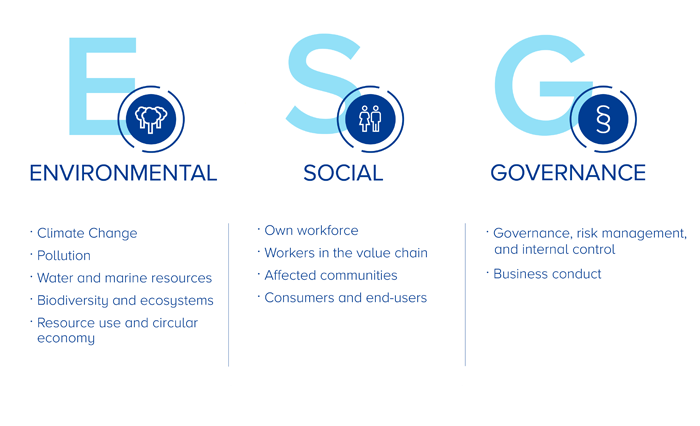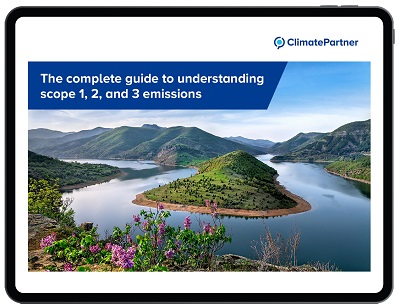What is the CSRD and how will it affect your business?
October 25, 2023by Björn Bröskamp and Sibylle Simon
ClimatePartner published the first version of this article on 27 January 2022 and has updated it numerous times. It now reflects the current status as of October 2023.
The Corporate Sustainability Reporting Directive (CSRD) is the EU's new reporting guideline, set to replace the Non-Financial Reporting Directive (NFRD). It was proposed by the EU Commission in 2021 and will be applicable for the first time for the reporting of fiscal years beginning on or after 1 January 2024.
The new directive aims to significantly increase transparency in the field of sustainability. With it, more detailed reporting requirements will come into effect, making the CSRD an important element to be considered within a company's management reporting and business activities. It is stricter in guidance and broader in scope than the NFRD, applying to four times as many companies across the EU.
Who should be prepared for the new reporting?
The widened scope of the CSRD means that instead of around 11,600 entities that currently report their non-financial data, the new directive will ask nearly 50,000 businesses to report, with around 15,000 in Germany alone. Companies that fulfil at least two of the following three conditions will have to comply with CSRD:

It is not only EU-based companies that need to pay attention to this change. The CSRD applies to any company with at least one large or listed EU subsidiary, or at least one branch with a net turnover of €40 million in the EU, that has also generated a net turnover of more than €150 million on the European market in the last two consecutive financial years.
If both these conditions apply, the company falls under the reporting obligation of the CSRD, and the EU subsidiary or branch is responsible for publishing the sustainability report of the third-country company. The Directive thus covers all relevant business activities that take place within the EU.
The planned CSRD does not foresee any new requirements for small and medium-sized enterprises (SMEs), unless they are capital-oriented. For these, the Commission wants to introduce separate sustainability reporting standards.
The regulations will come into effect in four stages:
- On 1 January 2024 for companies already subject to the NFRD (reporting in 2025 on 2024 data).
- On 1 January 2025 for large companies not currently subject to the NFRD.
- On 1 January 2026 for listed SMEs and for small and non-complex credit institutions and captive insurance companies. Companies falling under this category will have the option to choose not to report on sustainability matters under CSRD until 2028, provided that an explanation is given in the annual report as to why they have chosen not to do so.
- On 1 January 2028 for non-EU companies falling under the CSRD reporting obligation.
How to publish sustainability information
With the new CSRD in place, sustainability reporting will be a mandatory part of management reports. Separate sustainability reporting will no longer be an option, as it is with the NFRD now. This means sustainability is seen as a strategic element of a company's business activities. This approach is greatly welcomed, since it gives sustainability topics the same prominence as financial reporting and no longer treats sustainability KPIs as measurements of a lower priority.
All relevant company information, including information on sustainability activities, will have to be published in management reports and must also be disclosed and accessible in a digital, machine-readable format.
CSRD reporting applies to all companies that fulfil the criteria mentioned above. A company is exempted from its publishing obligation only when it is part of a parent holding company and can instead refer to the parent company's report, provided that this report is in accordance with the EU reporting requirements. The exempted subsidiary company is then required to publish a consolidated management report of the parent company's reporting at group level. It is also required to include a reference to the fact that the company in question is exempted from the requirements of the Directive. For all reporting companies, an external audit will be mandatory to provide limited assurance of the report.
What information needs to be disclosed
The current version of the CSRD only contains an overview of the prescribed reporting content. A detailed version of the planned reporting standards was prepared by EFRAG and the drafts of the 12 ESRS were submitted to the EU Commission on 22 November 2022. The aim is to bring the ESRS broadly in line with international reporting standards and existing sustainability reporting standards, such as those of the Global Reporting Initiative (GRI), the Sustainability Accounting Standards Board (SASB), the Carbon Disclosure Project (CDP), and others. Some of these standards also refer to the Greenhouse Gas Protocol. The CSRD and ESRS are also intended to be aligned with the EU Taxonomy.
The first set of reporting standards was adopted at the end of July 2023. A second set of reporting standards, which are sector-specific and adapted to different company forms, is to follow by 30 June 2024. The Commission will review the standards every three years after the Directive enters into force to take into account new developments such as international standards.
The Directive stipulates that the following environmental, social, and governance (ESG) aspects be considered when drawing up the reporting standards. They have each been compiled by EFRAG in the 12 reporting standards:

Another new requirement of the CSRD is the principle of double materiality. This principle asks companies to report from two different perspectives: how each sustainability aspect affects the company (the "outside-in" perspective) and how each reporting aspect of the company affects people, stakeholders, and the environment (the "inside-out" perspective). With that, the current comply-or-explain approach of the NFRD will no longer be applicable.
Outlook
Since the Commission adopted the ESRS as delegated acts, the standards are now mandatory for reporting. The new obligations will apply from the 2024 financial year at the earliest, meaning the first reports under the new Directive will be published in 2025.
The outlook is clear: Climate action and transparent reporting on corresponding measures are becoming mandatory for companies. In addition, the new directive will advance climate action, promote trust, and create a positive incentive for all companies to take responsibility. As one of several legislative initiatives, the CSRD provides both more clarity and more recognition of companies' commitment to climate action.
ClimatePartner supports you in complying with the CSRD
Companies can seek support in complying with the new reporting requirements from external experts such as ClimatePartner. As carbon accounting will be a focus of future reporting, ClimatePartner is ideally placed to share its expertise. The various calculations of the carbon footprint of companies, products, and services, as well as the corresponding reports, will be able to be included in CSRD reporting. We also support our clients in defining clear climate action strategies and aligning them with the requirements of the Science Based Targets initiative (SBTi) and, in the medium term, with a net zero strategy. Such strategies, developed in cooperation with our consulting teams, can also be integrated into compliant sustainability reports. The social impacts of our climate projects will also be applicable for reporting in accordance with the CSRD.
